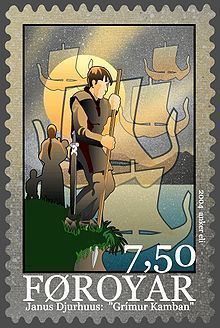Nationality Norwegian (Norse) | Occupation Settler | |
 | ||
Died 9/10th centuryFaroe Island Known for First Norse to appear in Faroe Islands | ||
Grímur Kamban was, according to the Færeyinga saga, the first man to set foot in the Faroe Islands. The name was written Grímr in Old Norse and often Grim in English.
Contents
Settlement of the Faroe Islands
The saga says, he was a Norwegian Viking escaping the tyranny of the Norse king Haraldur Hárfagri. However, this is an error in this saga, because Harald's age was in the late 9th century, while the first Norse settlers reached the Faroes after 825.
"According to the Færeyinga saga... the first settler in the Faroe Islands was a man named Grímur Kamban - Hann bygdi fyrstr Færeyar, it may have been the land taking of Grímur and his followers that caused the anchorites to leave... the nickname Kamban is probably Gaelic and one interpretation is that the word refers to some physical handicap, another that it may point to his prowess as a sportsman. Probably he came as a young man to the Faroe Islands by way of Viking Ireland, and local tradition has it that he settled at Funningur in Eysturoy."It was also Irish monks, who settled in the Faroes from about 625, which is today proved by botanical researches. According to Dicuil, those monks left the islands before 825 after Viking raids. Thus Grímur Kamban is supposed to be the first man, who re-settled the Faroes.
It is said that he settled down in Funningur on Eysturoy. The name funningur means finding. Excavations have shown Viking houses in this area, as well as all over the Faroes.
Name
The name Kamban indicates Celtic origins. Thus he could have been a man from Ireland, Western Isles or Isle of Man, where the Vikings already had settlements. Another theory says, he could have been an early Christianized Norwegian under the influence of Irish monks there.
If Gaelic, the first part of Kamban would originate in the Old Gaelic camb crooked (found in the Scots names Campbell Caimbeul Crooked-Mouth and Cameron Camshròn Crooked Nose). The word Kamban itself would there most likely be from cambán (Modern Irish camán, Scots Gaelic caman, Manx camane), roughly translatable as crooked one. The sports reference refers to the use of camb also in the term cambóg, which refers in origin to the type of stick used in games like hurling, hockey and golf.
